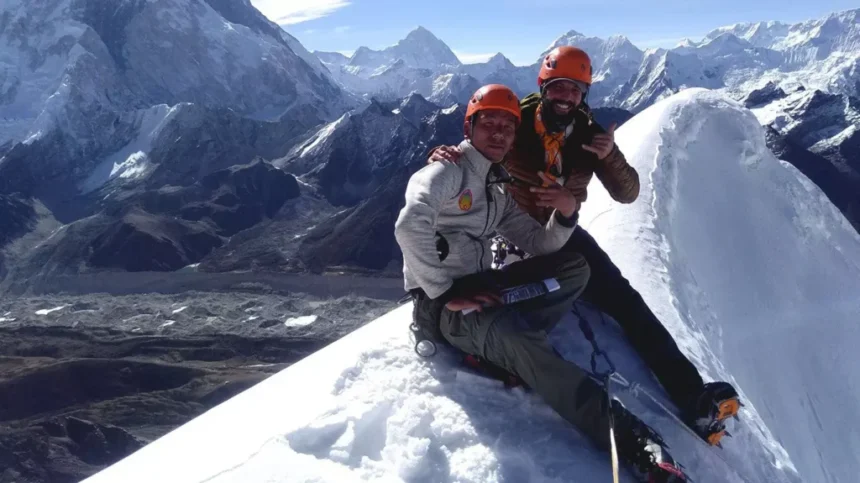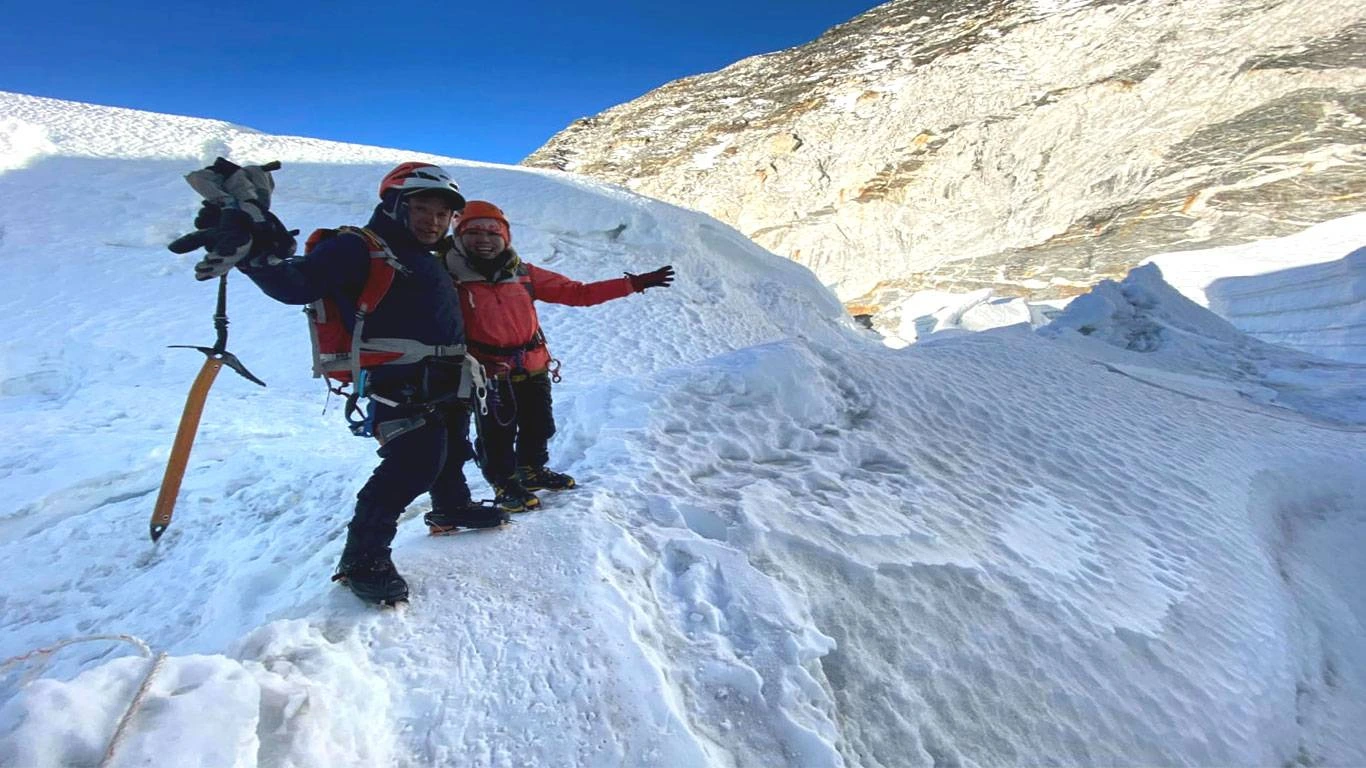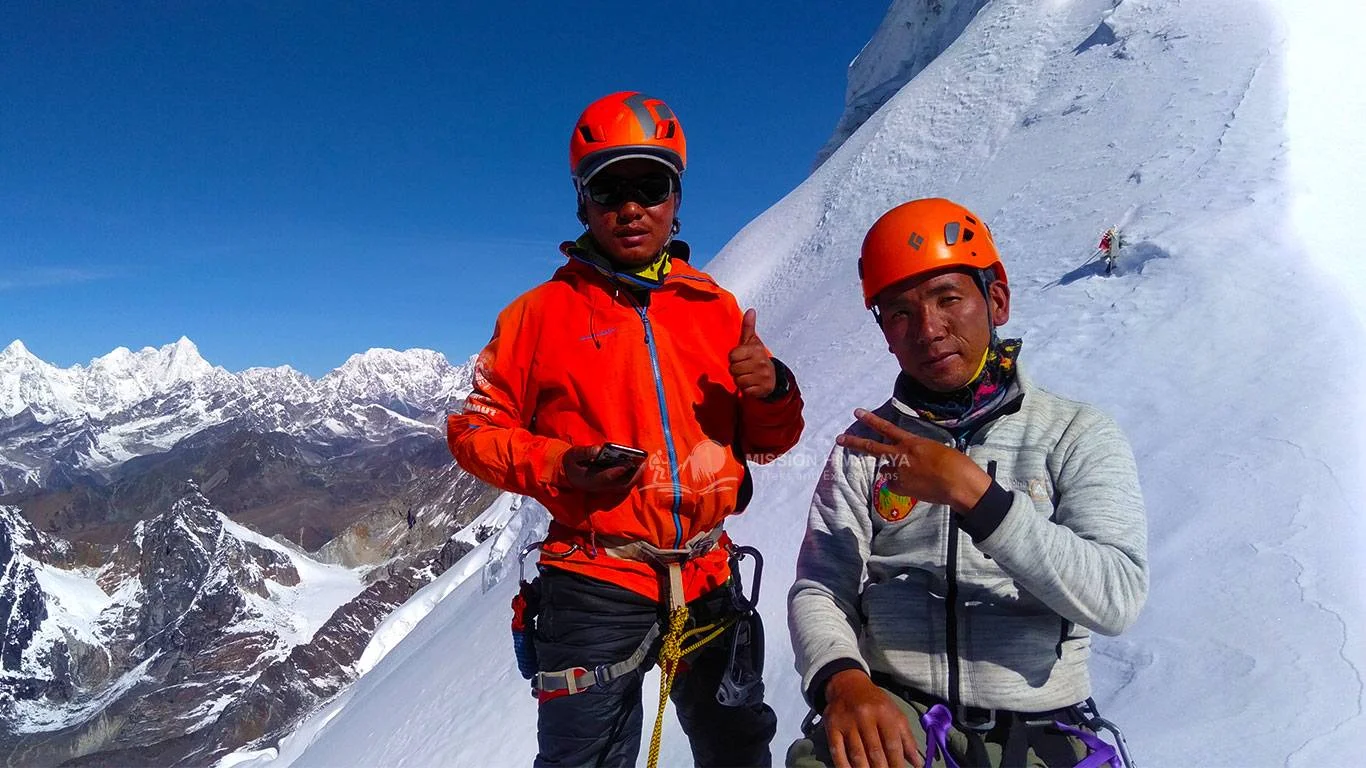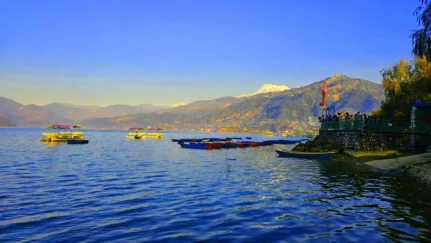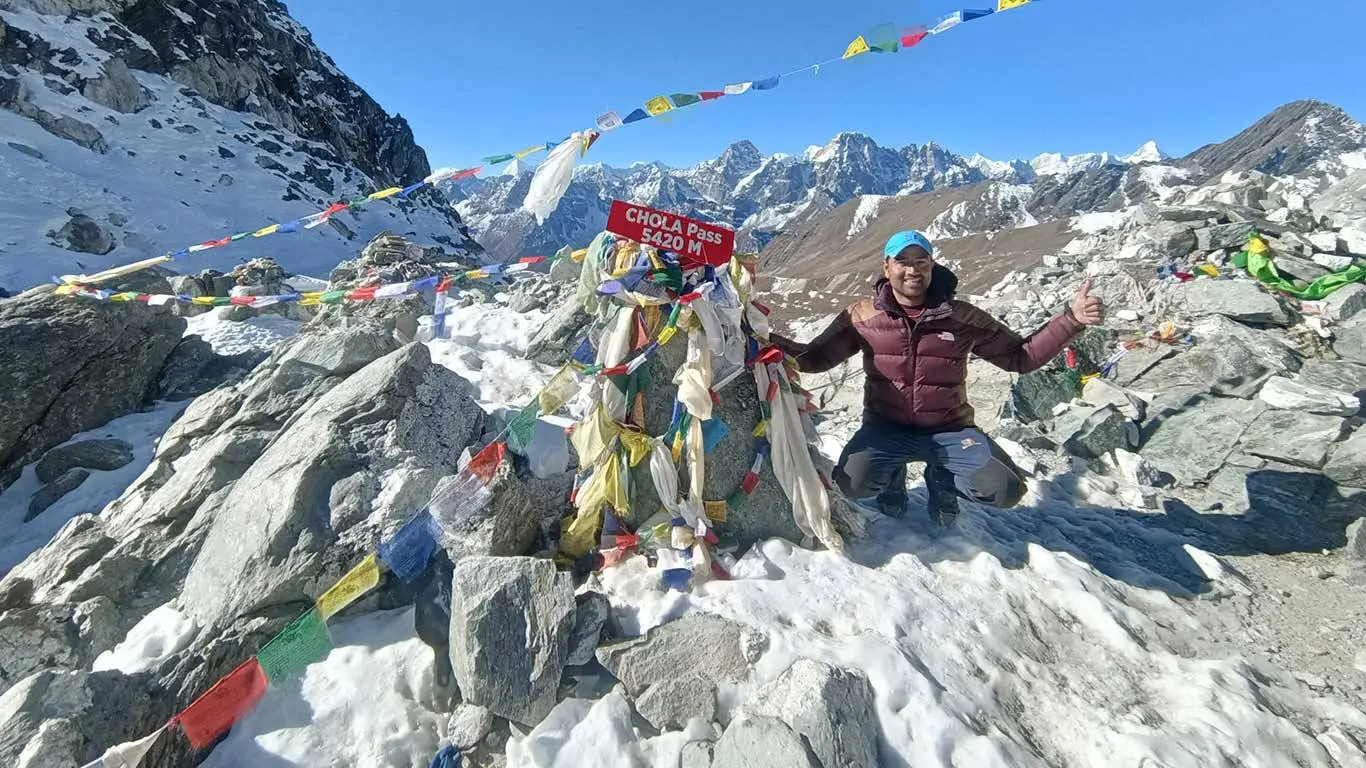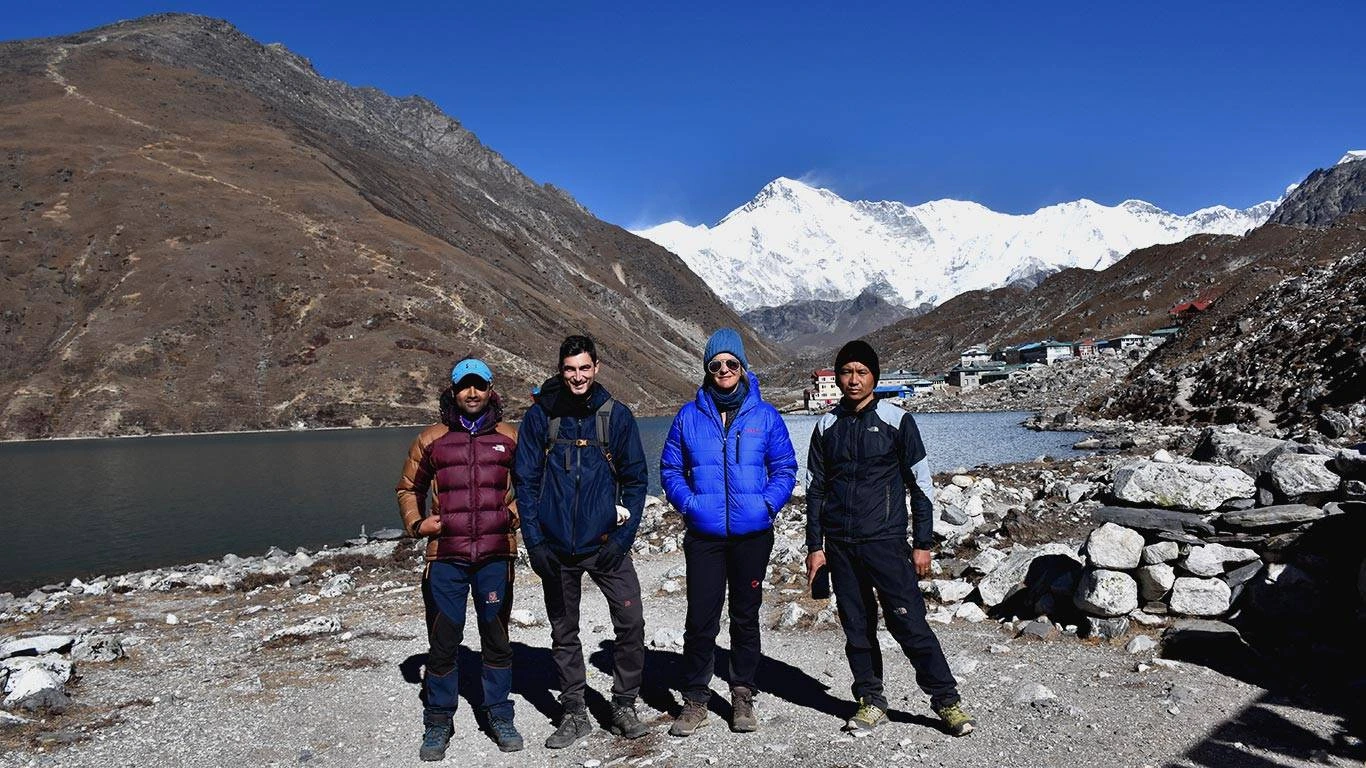Island Peak, also called Imja Tse, is one of Nepal’s most exciting climbing adventures. Standing at 6,189 meters (20,305 feet), this peak is perfect for beginners and experienced climbers alike. It’s not just about reaching the top—it’s about the journey through breathtaking landscapes, amazing cultures, and a sense of personal achievement.
When planning your trip, understanding the Island Peak climbing season is super important. The right season can make your climb safer, more enjoyable, and even more memorable. You’ll get to enjoy the best weather, clear mountain views, and great trekking paths when you pick the perfect time.
The two best Island Peak climbing seasons are spring (March to May) and autumn (September to November). During these times, the weather is stable, skies are clear, and temperatures are just right for climbing. Spring brings blooming flowers and green hills, while autumn offers crystal-clear views of snow-capped peaks.
Climbing during the monsoon (June to August) or winter (December to February) is much harder. The monsoon season has heavy rains, making trails slippery and dangerous, while the winter season brings freezing temperatures and deep snow. If you’re an experienced climber looking for a challenge, you might still enjoy these off-seasons, but they’re not for everyone.
Whether you’re a first-time climber or a seasoned mountaineer, knowing the best Island Peak climbing season can help you plan the adventure of a lifetime. So, pack your gear, train well, and get ready to experience one of Nepal’s most stunning peaks. The right season can make all the difference!
This introduction gives you an idea of why timing matters and how you can make the most of your climb.
Why the Season Matters for Island Peak Climbing Success
Choosing the right Island Peak climbing season is one of the most important steps to ensure a safe and successful climb. The weather, trail conditions, and your overall experience depend a lot on the time of year you decide to go.
Island Peak is a high-altitude climb that requires stable weather and clear skies for the best chance of success. During the ideal seasons, like spring (March to May) and autumn (September to November), the weather is much more predictable. Clear skies mean better visibility, making it easier and safer to navigate the trails and climb the peak. You also get to enjoy the stunning views of the Himalayas without clouds blocking the scenery.
If you climb during the wrong Island Peak climbing season, like the monsoon (June to August) or winter (December to February), things can get tricky. The monsoon brings heavy rain, making the trails muddy and slippery. In winter, freezing temperatures and deep snow can make the climb much harder and even dangerous. These conditions can also increase the risk of altitude sickness or other health issues.
Another reason the Island Peak climbing season matters is the level of support you’ll get. During the popular seasons, more trekkers mean better-maintained trails, fully operating lodges, and more guides and porters available to help. Off-season climbing may leave you with fewer resources, which can make things challenging.
In short, picking the right season is key to making your climb successful and enjoyable. It’s not just about reaching the summit—it’s about enjoying the journey safely while taking in the beauty of the Himalayas. A good season can turn your Island Peak adventure into a memory of a lifetime.
Spring Climbing (March to May): A Vibrant Adventure
Spring is one of the best times for Island Peak climbing. During this season, from March to May, the weather is just right, and the surroundings come alive with vibrant colors. It’s no surprise that this is one of the most popular times for climbers to visit.
The Island Peak climbing season in spring offers clear skies and stable weather, making it ideal for high-altitude adventures. Daytime temperatures are mild, usually ranging from 10°C to 15°C (50°F to 59°F) at lower elevations, while nights are cooler. Higher up, it can get much colder, but it’s still manageable for most trekkers and climbers with proper gear.
One of the most exciting parts of climbing in spring is the stunning scenery. The trails are surrounded by blooming rhododendrons, and the valleys are lush and green. As you trek toward Island Peak, you’ll be treated to breathtaking views of snow-capped mountains under clear blue skies. The beauty of the Himalayas feels even more magical during this time.
The stable weather in this Island Peak climbing season also means fewer risks of sudden storms or dangerous conditions. This makes it easier to plan your climb and increases your chances of reaching the summit successfully. Guides, porters, and lodges are all in full swing during spring, so you’ll have plenty of support along the way.
However, because spring is so popular, the trails can get a bit crowded. If you enjoy meeting other climbers and sharing the adventure, this can be a bonus! But if you prefer quieter trails, you might want to start your trek early in the morning to avoid the rush.
Spring truly offers a vibrant and unforgettable adventure. With the perfect combination of great weather, beautiful landscapes, and plenty of support, it’s no wonder this Island Peak climbing season is a favorite for so many. Pack your gear and get ready for an amazing springtime climb.
Autumn Climbing (September to November): Clear Skies and Ideal Conditions
Autumn, from September to November, is one of the most popular times for Island Peak climbing. During this season, the weather is calm, the skies are clear, and the trails are in perfect condition. If you’re looking for the best experience, the autumn Island Peak climbing season might be the right choice for you.
One of the biggest reasons autumn is so popular is the clear skies. The monsoon rains of summer are gone, leaving behind fresh, clean air and stunning views of the snow-capped mountains. Whether you’re climbing or just trekking to the base, the scenery is absolutely breathtaking. This season also offers the perfect chance for incredible photos with vibrant blue skies and crisp mountain peaks in the background.
The weather in autumn is stable and comfortable. During the day, temperatures are mild, usually between 10°C to 15°C (50°F to 59°F) in the lower regions, while it gets colder as you climb higher. At night, it can drop below freezing, so warm clothing is a must. The stable weather means fewer surprises, which makes planning and climbing much easier and safer.
Another great thing about this Island Peak climbing season is the lively atmosphere on the trails. Many climbers and trekkers choose autumn, so you’ll meet people from all over the world. Lodges, tea houses, and support services are fully operational, ensuring you have everything you need for a comfortable adventure.
However, because this season is so popular, the trails and campsites can get busy. If you prefer quieter climbs, booking your trek earlier or starting your day early can help you avoid the crowds.
Autumn truly offers ideal conditions for climbing Island Peak. With perfect weather, incredible views, and great support along the way, it’s easy to see why this Island Peak climbing season is a favorite for both beginners and experienced climbers. If you want a safe, enjoyable, and unforgettable adventure, autumn might be the perfect time to go.
Winter Challenges (December to February): Is It Worth the Risk?
Climbing Island Peak in winter, from December to February, is not for everyone. This time of year comes with freezing temperatures, harsh weather, and extra challenges. But for those seeking a unique adventure, this Island Peak climbing season might still be worth considering.
Winter in the Himalayas means cold days and even colder nights. At higher altitudes, temperatures can drop to as low as -20°C (-4°F) or even lower. The biting wind makes it feel even colder, so you’ll need high-quality gear like thermal clothing, sleeping bags, and sturdy boots to stay warm.
One of the biggest challenges during this Island Peak climbing season is the snow and ice. The trails can become slippery, and the climb itself requires extra effort to navigate icy sections. Climbers need to be experienced in using crampons, ice axes, and ropes. If you’re not used to these tools, winter might not be the best time for your climb.
On the bright side, winter has its own rewards. The trails and climbing routes are much quieter, as fewer people attempt the climb during this season. If you love solitude and the idea of being surrounded by untouched snow-covered peaks, winter might appeal to you. The views are also stunning, with crisp, clear skies offering breathtaking panoramas of the Himalayas.
Another thing to consider is the availability of support. Some lodges and tea houses may close during winter due to the cold and fewer trekkers. You’ll need to plan carefully to ensure you have the resources and support you need for your climb.
In short, the winter Island Peak climbing season is a challenge. It’s cold, tough, and requires more preparation. But for adventurers who enjoy a test of endurance and want a quieter, more rugged experience, it could be worth the risk. Just make sure you’re ready for the cold and have the right skills and gear before taking on this frosty adventure.
Monsoon Season (June to August): Why It’s Less Popular but Unique
The monsoon season in Nepal, from June to August, is the least popular time to climb Island Peak. Most climbers avoid this season because of the heavy rain and muddy trails. However, for those who are looking for something unique, the Island Peak climbing season during the monsoon offers a different experience that might be worth considering.
During the monsoon, the weather is wet, and it rains almost every day. This makes the trails slippery and harder to walk on. The heavy rain can also create mudslides and floods, making trekking dangerous in some areas. Many trekkers choose to avoid the Island Peak climbing season during these months because the rain makes the climb much harder.
Despite these challenges, the monsoon season also has its own special charm. One of the biggest advantages of climbing Island Peak during this time is the peace and quiet. Since most climbers stay away from the trail due to the rain, the routes are less crowded. If you enjoy a quieter adventure, you might find it exciting to have the mountains and trails almost to yourself.
The lush greenery around you during the monsoon is also stunning. The forests and valleys are full of vibrant plants, flowers, and fresh greenery. The air is thick with the smell of wet earth and plants, creating a very different atmosphere from the dry seasons. The waterfalls are also much more powerful and beautiful, flowing with fresh rainwater.
However, it’s important to be prepared if you decide to climb during the monsoon Island Peak climbing season. You’ll need to pack waterproof gear and be ready for wet conditions. The chances of clear views are lower due to the clouds and rain, but some climbers enjoy the misty and mysterious atmosphere.
In conclusion, while the monsoon season is not the best time for climbing Island Peak, it offers a unique and quieter experience. If you are ready for the challenges and want to enjoy the beauty of the monsoon, this Island Peak climbing season can be an unforgettable adventure. Just make sure you are well-prepared for the weather.
Comparison Chart
| Season | Weather | Temperature | Trail Conditions | Crowds | Views | Challenges |
| Spring (March to May) | Clear skies, mild weather | Day: 10°C to 15°C (50°F to 59°F), colder at night | Trails are clear and well-maintained | Moderate (popular, but not too crowded) | Stunning views of snow-capped mountains | Some altitude sickness risk, moderate difficulty |
| Autumn (Sept to Nov) | Stable weather, clear skies | Day: 10°C to 15°C (50°F to 59°F), colder at night | Trails in great condition, perfect for climbing | Busy (many climbers) | Clear, beautiful views of the Himalayas | Higher crowds, but ideal conditions for climbing |
| Winter (Dec to Feb) | Freezing cold, snow and ice | Day: -10°C to -20°C (14°F to -4°F), very cold at night | Snow and ice make trails slippery | Low (few climbers) | Crisp, clear skies with snowy views | Extreme cold, hard conditions, need for special gear |
| Monsoon (June to Aug) | Wet and rainy, cloudy | Day: 10°C to 20°C (50°F to 68°F), cooler at night | Slippery trails, muddy paths | Very low (least popular) | Views often blocked by clouds | Heavy rain, mudslides, dangerous conditions |
Tips to Prepare for Island Peak Climbing in Every Season
No matter what season you choose for Island Peak climbing, it’s important to be prepared. Each Island Peak climbing season comes with its own set of challenges and conditions. Here are some tips to help you get ready for your adventure, no matter when you plan to go.
Prepare for the Weather
Each season brings different weather, so knowing what to expect is crucial. In Spring and Autumn, the weather is usually mild and clear, but it can still get cold at night. Bring warm clothes, especially layers, so you can adjust as the temperature changes. In Winter, the cold is much more intense. You’ll need high-quality winter gear, such as a thick sleeping bag, thermal layers, and waterproof boots. For the Monsoon season, prepare for rain. Pack waterproof jackets, pants, and gear to stay dry.
Pack the Right Gear
Your gear will depend on the season. In the Island Peak climbing season of Spring and Autumn, make sure you have sturdy trekking boots, a comfortable backpack, and enough water to stay hydrated. If you’re going in Winter, don’t forget extra warm clothing and climbing equipment like crampons and ice axes. In the rainy Monsoon season, bring waterproof gear like ponchos and trekking poles to avoid slipping.
Train Your Body
Island Peak is a challenging climb, and it’s important to be in good physical shape. Regardless of the season, train your legs, core, and cardio to handle the steep trails and high altitudes. You can do activities like hiking, running, or cycling. Climbing in Winter will require even more strength, as the conditions are harder. Practice with heavy backpacks to get your body used to carrying weight during the climb.
Be Ready for Altitude
Altitude sickness can happen during any Island Peak climbing season because you’ll be climbing high into the Himalayas. Make sure you are ready for the altitude by taking it slow. Drink plenty of water and rest as needed. If you’re climbing in Winter, be extra careful, as the cold can make altitude sickness feel worse.
Know the Route and Plan Ahead
Before you go, research the route you’ll take. Knowing where you’ll sleep, what food you’ll have, and how long the trek will take helps you feel ready for the climb. The Island Peak climbing season can be busy, especially in Spring and Autumn, so plan your route and accommodations in advance.
By following these tips and getting ready for the challenges of each season, you’ll be all set for a successful Island Peak adventure.
Conclusion
In conclusion, choosing the right Island Peak climbing season for your adventure is key to a successful and enjoyable experience. Each season offers unique conditions that can affect your climb in different ways. Spring and Autumn are the most popular seasons, with clear skies and mild weather, making them ideal for most climbers. However, the Island Peak climbing season in Winter offers a quieter, more challenging experience with stunning, snowy views, while the Monsoon season brings a quieter atmosphere but also wet and muddy trails that can make climbing more difficult.
No matter when you decide to climb, proper preparation is essential. Make sure to pack the right gear, train your body for the climb, and be prepared for altitude sickness. Each Island Peak climbing season has its own set of challenges, but with the right planning, you can handle them and enjoy the beauty of the Himalayas.
The key to success in any season is patience, determination, and being well-prepared. By understanding the weather, knowing what to pack, and getting ready physically, you can make the most of your Island Peak climbing season and have an unforgettable adventure.
Birendra Duwadi by profession a trekking and tourist guide and an enterpreur whose passion is trekking in the himalayas start Mission Himalaya Treks in 2015 with a new vision to introduce Nepal Himlayas to the world. his vision is explore and documentation new trekking routes . Birendra leads Mission Himalaya, a small company that change the qualities of trekking in Nepal.

